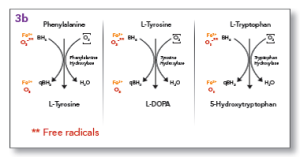Last week’s post covered the effect oxidative stress can have on the tryptophan pathway and potential decreases in serotonin synthesis. This week we will discuss how oxidative stress can also have a drastic effect on catecholamine (epinephrine, norepinephrine, and dopamine) synthesis.

Figure 1. BH4 is a necessary cofactor for the conversion of tryptophan to 5-HTP, phenylalanine to tyrosine and tyrosine to L-DOPA.
Tetrahydrobiopterin (BH4) is an essential cofactor in the synthesis of the monoamine neurotransmitters (Figure 1). BH4 is necessary for the conversion of phenylalanine to tyrosine, tyrosine to L-DOPA, and tryptophan to 5-HTP. However, BH4 is highly sensitive to oxidation and becomes irreversibly degraded to dihydroxyanthopterin (XPH2). Under conditions of oxidative stress, BH4 is rapidly destroyed and BH4-dependent enzymes are unable to perform their function. As a result of the decreased amount of BH4 available to act as a cofactor, lower levels of monoamines can be seen. When BH4 is decreased, the body may not be able to properly convert precursors because their enzymes can’t function without BH4. This can lead to lower levels of monoamines such as dopamine, norepinephrine, epinephrine, and serotonin. Deficiencies in these neurotransmitters have been associated with a myriad of clinical complaints such as depression, fatigue, attention difficulties, insomnia, and anxiety. Understanding the connections between oxidative stress and neurotransmitters is extremely important. These connections have the potential to impact a patient’s response to therapy if there is inflammation or oxidative stress affecting neurotransmitter levels. Assessing both neurotransmitter levels and immune activity is essential to ensure that you are utilizing the most clinically effective approach for symptom relief.

Pingback: Oxidative stress? Let’s take a look at DOPAC… | The NEI Connection